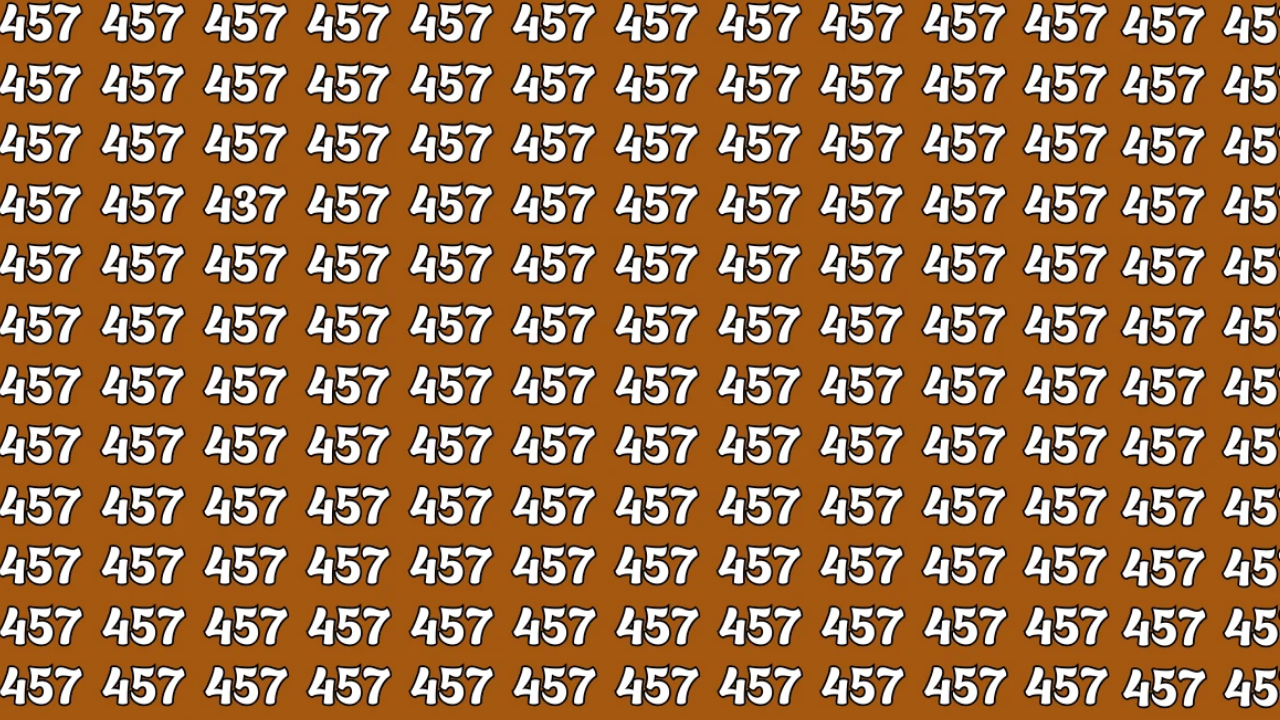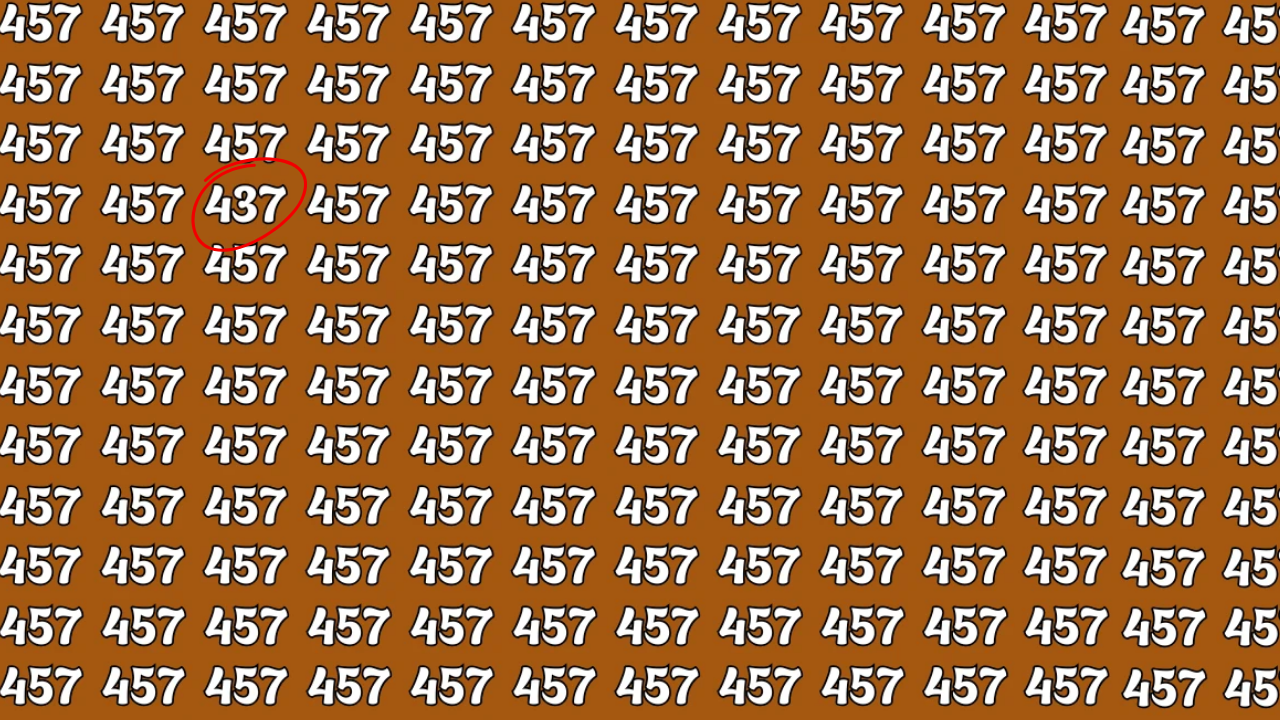Optical illusions have fascinated humanity for centuries, blending art, science, and psychology to create visual puzzles that challenge our perception. These mind-bending images trick the brain, making us see things that may not exist or overlook details hidden in plain sight. The “Optical Illusion 5 Seconds Challenge: Only People with Eagle Eyes Can Spot the Number 437” is one such viral puzzle that has captured the attention of puzzle enthusiasts worldwide. This challenge tests not only your visual acuity but also your ability to process information quickly under pressure. In this article, we’ll explore the science behind optical illusions, why this particular challenge is so captivating, and how you can train your brain to excel at spotting hidden details like the number 437.

What Makes Optical Illusions So Intriguing?
Optical illusions exploit the way our brains interpret visual information. Our eyes capture light and send signals to the brain, which then constructs an image based on patterns, colors, and contrasts. However, this process isn’t flawless. Illusions take advantage of the brain’s shortcuts, creating discrepancies between reality and perception. For instance, in the “Spot the Number 437” challenge, the number is camouflaged within a complex background of shapes, colors, or patterns, making it difficult to discern at first glance.
The time constraint of five seconds adds an extra layer of difficulty. It forces participants to rely on instinct and rapid visual processing rather than prolonged analysis. This combination of visual trickery and time pressure is what makes the challenge both frustrating and addictive. Only those with exceptional attention to detail—often referred to as having “eagle eyes”—can spot the number quickly.
The Science Behind Eagle Eyes
The term “eagle eyes” refers to individuals with superior visual perception, much like the bird of prey known for its incredible eyesight. Eagles can spot small prey from miles away, thanks to their high density of photoreceptor cells in the retina and a larger visual cortex for processing images. While humans don’t possess this level of natural vision, some individuals have honed their ability to notice fine details through practice or natural aptitude.
In the context of the 437 challenge, eagle-eyed individuals excel because they can filter out distractions and focus on subtle cues. This ability is linked to the brain’s visual cortex and its interaction with the prefrontal cortex, which governs attention and decision-making. Studies show that people with strong visual perception often have better neural connections in these areas, allowing them to process complex images faster.
Breaking Down the 5 Seconds Challenge
The “Optical Illusion 5 Seconds Challenge” typically presents an image filled with intricate patterns, colors, or numbers, where the number 437 is cleverly hidden. The goal is to locate the number within five seconds—a task that sounds simple but proves surprisingly difficult. Here’s why:
-
Camouflage Techniques: The number 437 may blend into the background due to similar colors or overlapping shapes. For example, the digits might be distorted or partially obscured, requiring you to mentally reconstruct them.
-
Visual Overload: The image is often designed to overwhelm the brain with information. Bright colors, repeating patterns, or clusters of other numbers distract from the target.
-
Time Pressure: Five seconds is barely enough time to scan the entire image, let alone pinpoint a specific detail. This forces participants to rely on quick pattern recognition rather than methodical searching.
To succeed, you need to train your brain to ignore irrelevant details and zero in on the number’s unique shape or contrast. Let’s explore some strategies to help you conquer this challenge.

Strategies to Spot the Number 437
If you’re struggling to find the number 437, don’t worry—there are ways to improve your chances. Here are some practical tips to enhance your visual perception and beat the 5-second challenge:
1. Relax Your Eyes
Staring too intensely at an optical illusion can cause your brain to “lock” onto irrelevant details. Instead, try softening your gaze or looking slightly to the side of the image. This technique, known as peripheral vision scanning, can help hidden patterns pop out.
2. Focus on Contrasts
The number 437 is likely to stand out due to slight differences in color, shading, or texture. Train your eyes to look for areas where the background shifts subtly, as these may outline the digits.
3. Break the Image into Sections
Rather than scanning the entire image at once, mentally divide it into quadrants. Spend a second or two on each section, looking for shapes resembling the digits 4, 3, or 7. This systematic approach can prevent you from feeling overwhelmed.
4. Practice Pattern Recognition
Optical illusions often rely on repeating patterns to hide details. Familiarize yourself with common illusion techniques, such as figure-ground organization (where the brain struggles to distinguish foreground from background) or gestalt principles (where the brain groups similar shapes together). The more you practice, the better you’ll get at spotting anomalies like the number 437.
5. Stay Calm Under Pressure
The five-second time limit can induce panic, which impairs visual processing. Take a deep breath and trust your instincts. With practice, your brain will learn to filter out distractions faster.

Why This Challenge Went Viral
The “Spot the Number 437” challenge has taken social media by storm, with users on platforms like X sharing their successes (and frustrations). Several factors contribute to its viral appeal:
-
Universal Appeal: Optical illusions are accessible to people of all ages and backgrounds. You don’t need specialized knowledge to participate—just a pair of eyes and a willingness to try.
-
Competitive Edge: The “eagle eyes” label adds a sense of pride for those who succeed, encouraging participants to challenge friends and family.
-
Quick Engagement: The five-second time limit makes it perfect for short attention spans, fitting seamlessly into the fast-paced world of social media.
-
Shareability: People love sharing their results, whether they spotted the number in record time or failed spectacularly. This creates a feedback loop, driving more users to try the challenge.
Posts on X reveal a mix of reactions, with some users boasting about spotting the number instantly and others humorously admitting defeat. The challenge’s simplicity, combined with its deceptive difficulty, keeps it trending.
The Benefits of Solving Optical Illusions
Beyond the thrill of victory, optical illusions like the 437 challenge offer cognitive benefits. Regularly engaging with visual puzzles can:
-
Improve Focus: Training your brain to filter out distractions enhances your ability to concentrate on tasks.
-
Boost Memory: Recognizing patterns and recalling visual cues strengthens short-term memory.
-
Enhance Problem-Solving: Optical illusions require creative thinking, which translates to better problem-solving skills in other areas of life.
-
Reduce Stress: Solving puzzles can be a fun, meditative activity that provides a mental break from daily stressors.
Research suggests that brain teasers, including optical illusions, may even delay cognitive decline in older adults by keeping the brain active. So, the next time you tackle the 437 challenge, know that you’re giving your mind a workout!
How to Create Your Own Optical Illusion Challenge
Inspired to design your own version of the 437 challenge? Here’s a step-by-step guide to crafting an optical illusion that will stump your friends:
-
Choose a Target: Pick a number, word, or shape to hide (e.g., 437).
-
Design the Background: Use graphic design software or online tools to create a busy background with patterns, colors, or shapes. Ensure the background complements but obscures the target.
-
Camouflage the Target: Blend the target into the background by adjusting its color, size, or orientation. For example, make the number 437 slightly lighter or darker than the surrounding area.
-
Test the Difficulty: Share the illusion with a few people to gauge how long it takes them to spot the target. Adjust the design if it’s too easy or impossible.
-
Add a Time Limit: Set a challenge duration (e.g., 5 seconds) to increase excitement.
-
Share It: Post your illusion on social media with a catchy title like “Only 1% Can Spot This in 5 Seconds!” and watch the engagement roll in.
Looking Forward
The “Optical Illusion 5 Seconds Challenge: Only People with Eagle Eyes Can Spot the Number 437” is more than just a fun puzzle—it’s a test of perception, focus, and mental agility. Whether you’re a seasoned illusion solver or a first-timer, this challenge offers a chance to sharpen your skills and join a global community of puzzle lovers. By understanding the science behind optical illusions and practicing proven strategies, you can train your brain to spot the number 437 in record time. So, take a deep breath, relax your eyes, and dive into the challenge. Do you have what it takes to earn the title of eagle-eyed champion?
